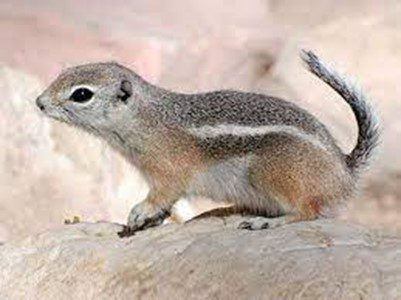The White-tailed Antelope Ground Squirrel

SQUIRREL? BUT ISN’T THIS A CHIPMUNK? DON’T LET THE STRIPES FOOL YOU!
“Fi-dee-dee…FEE-DEE-DEE…Fi-dee-dee-dee-deee!” Hikers and bike riders on the Clark County Wetlands Park Loop Trail often hear white-tailed antelope ground squirrels (Ammospermophilus leucurus) before they see them which is great news for the squirrels. When we do see them, they are often sitting up straight and tall, scanning the ground and sky around them for predators. They want very much to see before they are seen, and their twittering calls alert every other white-tail (and other critters as well) within earshot that a possible predator is near.
Being on the watch all the time can be the difference between life and death for a ground squirrel. So many predators just love a tasty squirrel dinner! Coyotes, roadrunners, hawks, foxes, badgers, bobcats, weasels and snakes head the list. Not so very long ago, white-tails were also hunted for food by local Native American groups. So, they are not paranoid. Lots of predators really are “out to get” them.
White-tailed antelope squirrels are among the most interesting creatures of the shrubby dry desert habitats where they live. They are easily recognized by the pair of white stripes stretching from shoulder to rump and the absence of the facial stripes found in similar-looking chipmunks. The tail is frequently carried over the back, white side gleaming in the sun! These “perky,” “lively,” “sprightly and restless” squirrels are not just pretty, but very well adapted to desert life. In fact, the genus name “Ammospermophilus” comes from the Greek word that literally means “lover of sand and seeds.”
Antelope squirrels avoid the worst of summer’s heat in well-excavated burrows with entrances protected by thorny shrubs or heavy rocks, where their young (4-14 in number) are born in softly lined nests in April or May. They carry home seeds and other foods in their cheek pouches to store underground. Though they will lap up water when available, they do not require it. They are able to tolerate high body temperatures, and are able to cool themselves when needed by lying flat in the shade with front and hind legs stretched out and bodies in contact with the ground. Their white tails, carried “jauntily” over their backs, also provide a bit of protection from direct sunlight.
Seeds, including yucca, salt grass, and the oil-rich seeds of brittlebush, form most of their diet, but the squirrels also enjoy new green herb growth, fruits, and the tender new growth on cactus plants when they are available. Unwary beetles, grasshoppers, crickets, and the occasional flying insect add bites of protein to round out the white-tail menu.
If you bicycle or hike along the Wetlands Park Loop Trail, be alert for the flash of white as an antelope squirrel runs from rock to shrub, and listen for their “fi-dee-dees” warning their neighbors of your approach. If you ever get the chance, make the acquaintance of an antelope squirrel serving as an education ambassador for a zoo or desert preserve – they are every bit as charming as they look!
I know this for a fact. I once raised a white-tail for a live exhibit at a museum where I worked. One of our neighborhood kids brought her in after a spring rainstorm washed out her mother’s burrow. “Lady, lady,” he said, holding out his hand where this naked pink baby, smaller than my thumb, was kicking and peeping, “what do I do about this?” After a trip to the vet for rodent formula and three sleepless nights (she had to eat one drop of formula every hour to begin with), we could see the beginnings of her white stripes and knew what she was. We named her Pennant (for the tail, of course), and she lived with us in the exhibit for eight years. When I reached into her habitat, she always ran and jumped into my hand, snuggling down on her side and peeking up at me with her large, soft, almond-shaped eyes. That definitely made it worth my lost sleep!
-By Chris Leavitt; photo by Jim Boone, Desert Wildlife Consultants, LLC and founder/editor of birdandhike.com.
Please enjoy these YouTube videos:
Antelope Ground Squirrels Springs Preserve 4:23
(SOUND ONLY – BUT FUN) Listening Earth Soundscapes Mojave White-tailed Antelope Squirrel 4:25
Antelope Ground Squirrel (Ammospermophilus leucurus) Cactus Harvest Xeric Specialties 1:00
White-tailed Antelope Squirrels (A. leucurus) Calico Basin LVegasUSA Antonio Silva 0:30
White-tailed Antelope Squirrel (Ammospermophilus leucurus) Red Rock Las Vegas Antonio Silva 0:31
